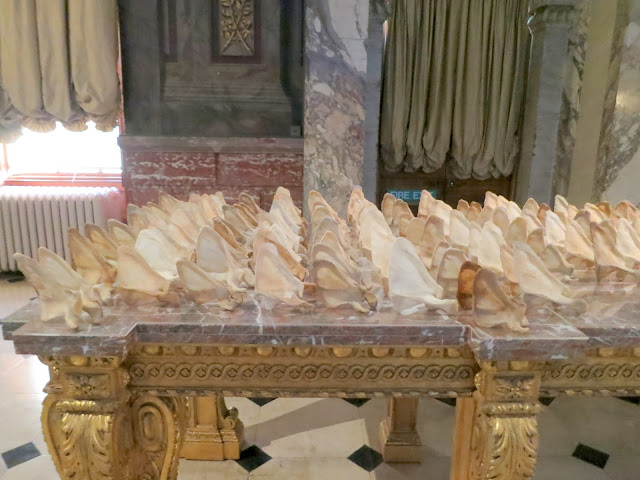Softer, by Jenny Holzer
at Blenheim Palace.
This exhibition is based on themes of modern conflict, history and memory. The work centres on the power of language and its effect on society, especially in public spaces. Through language and through the use of an array of materials and processes, Holzer speaks of power, war, death and hope, bringing to light topics that are usually silenced or ignored.
Since 1993 she has increasingly worked with text from outside sources. For this exhibition she partnered with The Not Forgotten Association, a British charity that serves the needs of wounded injured, disabled and sick service members and ex-service members of the British military by providing a community and putting fun, enthusiasm, energy and enjoyment back into their lives. The Association collected testimonies from over fifty veterans and serving personnel in the UK.
Further text draws from first hand testimonies of refugees and others affected by the conflict in Syria, collected and charities Save the Children and Human Rights Watch and from Polish poet Anna Swirszczynska who wrote about her experiences in Warsaw during WWII. In selecting excerpts from this large archive of first-person testimonials, Holzer addresses the ways in which an understanding of war and violence cannot be abstracted from its lived experience.
Black mondo grass:
Black mondo grass has been planted throughout the Palace.
The procession of black grass lining the pathway in the Palace's Great Court provides a signal that something may be amiss.
Stone works:
Holzer began to work with engraved stone in the 1980s, partly to complement the ephemeral formats with which she was working at the time (for example, posters or electronic signs temporarily displayed in public spaces). For this exhibition, Holzer created a series of new stone benches and a sarcophagus inscribed with text excerpted from the English translation of Anna Swirszczynska's collection of poems Building the Barricade, describing her memories of survival during the Warsaw Uprising at the end of the summer of 1944.
Electronic Signs:
Holzer has employed electronic signs since 1982, when she displayed her text on an electronic signboard in Times Square in New York City. LEDs are typically used to circulate news, information or advertisements, and Holzer uses the medium's public appeal to present content that is at times challenging.
In the Great Hall, a kinetic four-sided LED sign, Statement, presents poems by Anna Swirszczynska as well as accounts by Syrian refugees collected by Save the Children, and stories recorded by Human Rights Watch from Syrians subjected to torture under Assad's regime.

In the Long Library, curved electronic signs are installed around the bust of the 1st Duke of Marlborough. Multicoloured diodes illuminate text excerpted from testimonies collected by The Not Forgotten Association. These stories recount the rewards and trials of military service, as well as the challenges of readjusting to civilian life.
Bone installation:

In 1994, Holzer began incorporating human bones into her practice in the wake of the war in former Yugoslavia, where sexual violence against women and girls was a strategy and weapon.
This first installation is within the cabinets in the China Ante room.
The second installation is on a table in the Saloon.
Since the early 2000s Holzer has researched US government documents released to the public under the Freedom of Information Act (FOIA) and transformed these into oil and watercolour paintings. The content of the documents date back to Bush-era initiatives in Afghanistan and Iraq. Each painting is true to the vernacular of the original. The document is digitally enlarged and the content is meticulously traced to faithfully reproduce the text and also the traces of censorship and concealment which redact much of these documents' content. Holzer then adds colour to the documents, sometimes in lurid res and contrasting blues, overlaying a human touch on the digital format used to share, or conceal, information about the tactics of war.
looking closer
In 2004, Al-Qaeda and allied groups were the focus of another FBI report, 'The Terrorist Threat to the US Homeland: an FBI Assessment'. Thirteen pages of the forty-three page report were declassified in 2012, but even these few pages had been heavily redacted. Among the most striking is page 26, where only a single line of the report survived, with the subject heading 'Shifting to Softer Targets'.
This document provides information on medical guidelines for detainees, included in a fax sent to the Justice Department's Office of Legal Counsel by the CIA in 2005. The page is entirely redacted, with all information still withheld from the public.
























Powerful stuff. Interesting, and perhaps a little strange to see the redacted material in attractive colours. I remember the first time I encountered redacted material in a hotel lobby in Jakarta in the 80s when I was working there. I'd just bought an Economist magazine, and there was so much blacking out that it was almost unopenable. It was the heavy black, and the stickiness of the ink which made the immediate impact, and is physically memorable still. Jenny Holzer's representations of redaction look attractive and benign - especially if one does know the back story of the work.
ReplyDeleteI remember the blacking out in newspapers and magazines during the junta years in Greece - so sinister and scary. Those were awful years and I still shudder when I think about them.
ReplyDeleteYou are right about the representations of redaction in the exhibition, Olga. The same goes for the title, 'Softer'. Nothing is soft about the content of the exhibition, even though it could be referring to 'shifting to softer targets' in one of the documents, but still. She obviously wanted to play with these contradictions.